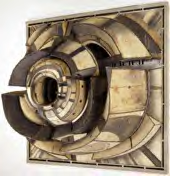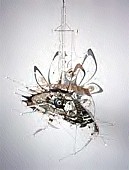
Bontecou, Untitled, 1962
The Lee Bontecou Problematic
Every time we go to the New York City Opera we look forward to seeing Lee Bontecou’s fine wall piece. There’s no mistaking it: dingy canvas stitched to metal “ribs,” a gaping hole. The center juts from the wall as if (excuse me, Herr Freud) it might eat you. Or is it the fuselage from hell? The artist herself apparently associates her imagery with the Second World War.
Titled “Untitled,” as was and is always her wont, I can’t say this particular work beats the primo Jasper Johns also on display, but it holds its own and far surpasses all the odd, puzzling, or simply unspeakable artworks placed here and there on various levels. Should I say it?The Johns and the Bontecou also surpass any art in the two other Lincoln Center halls.
I include an inexplicably immense Chagall at the Metropolitan Opera building and strangely invisible Richard Lippold suspended piece in the lobby of Avery-Fisher Hall. Chagall — never one of my favorites — is best with intimacy, and Lippold, now nearly forgotten, couldn’t counterbalance the sheer ugliness of the cheesy surroundings and the invisible upper-reaches of the lobby.
It is quite amazing actually that the New York State Theater, rising up on the shoulders of the notion of a people’s opera and Balanchine’s New York City Ballet, and designed by the elitist Philip Johnson should end up looking the best and having the best art of all the Lincoln Center buildings. We won’t even mention the notorious acoustical dead spot on the stage (a stage that, after all, was designed primarily for ballet, not opera) except to note that directors seem to be drawn to it like the abyss and habitually place divas there to sing — rather, mime — their most important arias.
But Bontecou cheek-by-jowl, or cheek-by-jewel, to Johns? I remember when Bontecou also showed with Leo Castelli — even Don Judd, wearing his critic hat, liked her work — and then she disappeared. Was it really because everyone hated those dreadful vacuum-molded, hanging plastic fish?
Yes. She took offense at the bad reviews. Divas do not tolerate criticism.
As luck would have it, her disappearance was in the long run fortunate. Discouraged, she apparently stopped making those fish. She began a teaching stint at Brooklyn College, so far away; and hid out in a studio in Pennsylvania, apparently also off the map. And now at the age of 73, she’s back. She’s this year’s comeback queen. Every art career needs a touch of myth. Running off to Tahiti or cutting off your ear or dying in a drunken car crash won’t work anymore. But we all love the comeback story, particularly when it includes “gone but still here.”
I say that her disappearance was fortunate for, as the current retrospective (and last exhibition at the temporary MoMA QNS, closing Sept. 27) proves, those fish were bad, the artist’s pro-ecology sentiments notwithstanding. The smaller, free-standing oceanesque creatures and, of course, the drawings of this period are fine. But those fish! They should be lamps. Without them, however, there could be no mobiles to follow.

Untitled (Hanging Sculpture), 1991
The mobiles – aquatic, but also celestial – are ecstatic. Sometimes an artist has to fail in order ultimately to succeed. We could not have known at the time that the plastic fish would later be seen as steps not as ends. If the plastic fish had been warmly received, if Bontecou had stayed around (in the swim, as it were), if somehow she could have acknowledged the vaginal imagery of her signature works (thus binding herself to feminism of a certain sort), would she, could she have come up with the mobiles?.
Would Agnes Martin be the icon she is if she had stayed in Manhattan? Or Georgia O’Keeffe? Moving to Connecticut didn’t help Richard Pousette-Dart. Perhaps he should have moved to the Southwest. The new rule seems to be: women, run away; men, stay.
Since all of this might sound flippant, I should say I was deeply moved by the stitched-to-metal canvas works and the recent mobiles. The best of the wall- sculptures, which also can be seen as relief-paintings, aggressively balance illusion with materiality, a materiality predicated on the use of (to quote more than one label) “welded steel, canvas, velveteen, saw blades, rope, pipe fittings, soot, spools, washers, grommets and wire.”
One of the reasons the two billowy, mostly fiberglass pieces don’t really work is that the materials have no history in themselves. “Untitled” of 1966 even has lights inside of it. Bontecou’s Schwitterness is replaced by what used to be called Pace Gallery slickness: plastic, plastic, plastic.
Pace, presently PaceWildenstein, is now so blue chip that art history forgets that at its birth, Pace taste preferred plastic to passion. The vitrine became the sculpture. I am thinking of the otherwise admirable Paul Tek, whose creepy meat sculptures were so distanced by their manner of display, they could pass for a weird kind of minimalism.
One reason Bontecou’s mobiles — by the way, the only worthwhile addition to the genre since its inception by Alexander Calder — fascinate, elevate, agitate, radiate is that they have hearts of porcelain. The porcelain chunks are the equivalent of the wall-sculpture holes, for it is a material, clay, that the art world has been trained not to see.
Could we not be any more forewarned than by the judicious placement of Bontecou’s 1957 terra-cotta sculpture right at the entrance to the stingy MoMA QNS galleries devoted to her life’s work?
But all is not smooth sailing. The real question is not whether or not the artist should have been arrested for lifting those U.S. Mail canvas bags she found beneath Avenue B letter boxes. The real question is: Are the prime works (the stitched canvas wall-pieces and the new mobiles) Cubist? This is Issue #3.
In case you haven’t noticed, all my essays address issues. This is why, I suppose, some use ARTOPIA as a reading assignment for their art students. Yet I am not writing a textbook: I am just trying to see below the surface of things. I do not believe, as one once famous artist once said, that in terms of art what you see is what you get. A fan once accused me of solving problems he didn’t know he had. At least I think he was a fan. Philosophers, when there were philosophers, were often accused of that very same thing.
Issue No. 1: How does timing and myth apply to an art career? Are there gender differences?
Issue No. 2: Is it a good idea to name all artworks you make “Untitled?” How on earth can you easily refer to specific pieces by Bontecou, since she made more than one “Untitled” in each year, without giving dimensions or citing what institution now owns the piece? Even so, the Chicago Museum of Contemporary Art owns at least two. We are art critics, not registrars. Titles (other than “Untitled”) allow easy retrieval and identification. On the other hand, if you don’t want to skew the viewer’s interpretation, anything other than “Untitled” or a simple number can be a problem. Even a nonsensical title can yield strange and possibly irrelevant viewpoints. But, the evil questioner asks, are there any irrelevant viewpoints?
Issue No. 3. Is Bontecou a Cubist?
Bontecou’s best canvas wallpieces and her recent mobiles are not as Cubist as the fiberglass pieces. For all their piecework, they have strong centers; Cubism does not. Most classical Cubist paintings, by Braque or Picasso, have weak centers if the motif is a personage and none at all if a still-life is getting the Cubist multiple-viewpoint treatment. Yet, it cannot be denied that there is a Cubist aroma to all of her works. Also, if there’s a classical Cubist color, it’s tan, and that’s Bontecou’s color. Is this horrible?
I remember when a certain self-proclaimed intellectual, now a film historian, returned from Paris (where she had written impenetrable art reviews for an
English-language newspaper), pinned me down at a party and asked me two things: “Well, Monsieur PEAR-oh, how does it feel to be the most-read critic in New York?”
I hate people perversely Frenchifying my name. I was writing for the Village Voice, but never thought myself worthy of being accused of being too popular, which was really what she was doing. And then she asked: “And what does everyone think of de Kooning now?” Too Cubist, I blurted out. And said “intellectual” made her bed with the Minimalists from that point on. Could I have been wrong?
No. I was just wrong in going along with the consensus suggesting there was something sinful about being a Cubist. Too fussy, too compositional, too French.
One of my fantasy exhibitions is a Cubist update; that would be a real shocker, for everyone assumes that Jackson Pollock, Field Painting, Color Field, Post-Painterly Abstraction, and Minimalism wiped out Cubism. I have thought this and taught this myself.
I now subscribe to the theory (my own) that art history is best seen as a braided spiral: many strands going on at once, many things skipping back and forth through time, coming back, disappearing. By the way, the braid that turns back into itself as in a Arabic or Celtic knot is my image for the spiritual in art — the timeless.
So what would this new view of Cubism look like? We’d start with the classical Analytical Cubism of Picasso and Braque and not branch into Futurism (and thus Dada, etc.) but skip to de Kooning, then Robert Rauschenberg and Jim Rosenquist and Lee Bontecou. And then, whether I like the work or not (I don’t) I’d have to include post-target/post-number Johns and post-protractor Stella. Surfaces and images are fractured, as is space and time. Note that I have chosen Classical Cubism, i.e. Analytical Cubism not Synthetic Cubism, which I find only pleasing.
But Neo-Cubism is probably not worth a dime, since the Greenbergers (although Clem himself once thought Pollock was extending Cubism) made the sales point that Pollock, Noland, early Stella and the rest were all anti-Cubist, anti-composition, as if it were really true that there is no intra-textual, relational, going back and forth among forms and/or colors. Cubism was un-American and, besides, one had to take the next step. Art is always involved with taking the next step.
Future issue: Is there always a next step?
